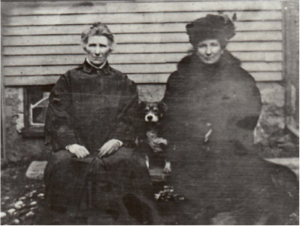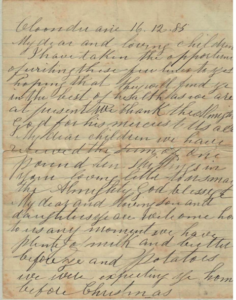We shall not cease from exploration
And the end of our exploring
Will be to arrive where we started
And know the place for the first time.
T.S. Eliot, “Little Gidding”
My discovery of a letter, almost five decades ago, marked the starting point for exploring the Irish roots of my father’s maternal grandmother, Annie Flynn Cassidy (1856–1919). Annie and her sister Ellen Flynn emigrated to Fall River, Massachusetts, around 1881.[1] On 16 December 1885, their father John Flynn wrote this letter from Cloonduane acknowledging money the sisters sent home and the news of Annie’s recent marriage to Patrick Cassidy. Presumably Cloonduane was near Castlebar, County Mayo, the town cited as Annie and Ellen’s birthplace in their obituaries from Fall River newspapers.
This wonderful document “from the old country” did not easily link to Ireland. Finding the location of Cloonduane took years. The name did not appear in General Alphabetical Index to the Townlands and Towns, Parishes and Baronies of Ireland (1851). As a Boston College undergraduate, I made several appointments with Helen Landreth, fabled curator of the Irish collection at Bapst Library. We found nothing among County Mayo histories and gazetteers. Miss Landreth always steered the conversation to poet Robert Emmet, whose portrait hung on the wall.
In response to a 1992 query to the Mayo County Library, Ivor Hamrock, archivist, answered that Cloonduane corresponded to the townland of Curraghmore in the parish of Balla, and he hand colored its approximate location on a map. Hamrock also provided me with the names of possible Flynn relatives who continued to live there. Of course, I wrote right away to one of them and received an answer seven years later!
Of course, I wrote right away to one of them and received an answer seven years later!
Researching Irish roots today belongs to a different world, as Ireland is completely caught up in the Digital Age. Today, one may google “Cloonduane” and the hits pop up: from links to the Tithe Applotment Records of 1837 to current real estate prices. The National Archives of Ireland has online census records as well as indexed and scanned images from parish registers. Commercial sites offer even richer sources, such as Land Estate Rentals and court records. Compared to the meager scraps I painstakingly assembled, I can now indulge in a feast that appears on my computer screen.
This infusion of accessible material still leaves me eager for more, and that remains the challenge for those of us with rural Irish ancestors because the paper trail often goes cold early in the nineteenth century. That is the case with Annie and Ellen’s parents, John Flynn and Bridget Staunton, married in the parish church of Balla on 6 December 1841. Who were their parents? Future discoveries lie in wait as I comb the digitized church records for more clues on collateral families.
 Wanted! Grandparents, aunts, uncles, and cousins for Annie (Flynn) Cassidy and her sister Ellen Flynn, pictured here outside their Fall River home, circa 1905.
Wanted! Grandparents, aunts, uncles, and cousins for Annie (Flynn) Cassidy and her sister Ellen Flynn, pictured here outside their Fall River home, circa 1905.
Bridget (Staunton) Flynn has only three living mt DNA descendants, one of whom has consented to have a DNA test. Likewise, John Flynn has a patrilineal descendant with an interest in genealogy. And, thus, with my roots in Cloonduane having coming full circle, I am ready to start again with new tools.
Note
[1] For more on Ellen’s life in Fall River’s mills, see “Ellen Flynn, Speeder Tender,” American Ancestors 14 [2013]: 30–32.
Share this:

About Michael Dwyer
Michael F. Dwyer first joined NEHGS on a student membership. A Fellow of the American Society of Genealogists, he writes a bimonthly column on Lost Names in Vermont—French Canadian names that have been changed. His articles have been published in the Register, American Ancestors, The American Genealogist, The Maine Genealogist, and Rhode Island Roots, among others. The Vermont Department of Education's 2004 Teacher of the Year, Michael retired in June 2018 after 35 years of teaching subjects he loves—English and history.View all posts by Michael Dwyer →
